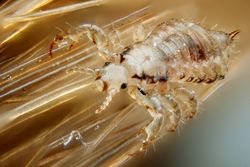Pediculus humanus
| Literature database |
|---|
| 174 articles sorted by: |
| • year (descending) |
| • research topics |
| • countries/regions |

Author(s): Gilles San Martin
Source: Wikimedia Commons
Pediculus humanus Linnaeus, 1758 - (head louse, body louse)
Humans are parasitised by 3 types of lice. The head louse (Pediculus humanus capitis), the body louse (Pediculus humanus humanus) and the pubic louse (Pthirus pubis). Of these the head louse is the most common and important parasite. It had a world-wide distribution and infestations are common in some regions.
The lice feed on the human scalp by injuring the skin and sucking blood, causing irritation which may lead to secondary bacterial infections (e.g. by Staphylococcus aureus). Allergic reactions can also develop. The insect can further transmit several diseases, like louse-borne relapsing fever (Borrelia recurrentis) or louse-borne typhus (Rickettsia prowazeki ).
| Vernacular names | |
|---|---|
| • Deutsch: | Menschenlaus Kopflaus Kleiderlaus |
| • English: | body louse head louse clothing louse |
| • Español: | piojo humano |
| • Français: | pou de l'homme |
Many million people, especially children are affected by lice. In the United States alone, the overall annual costs of control as well as medical treatments have been estimated at around 1 billion US$. Head lice spreads through direct contact, e.g. among children in school. The claw-like legs are well adapted to holding on to and moving along hairs.
Many types of treatments like shampoos are available against head lice. However, these often do not remove or kill the egg stage. Therefore, 3 treatments at intervals of 1 week are recommended to control any nymphs which might have hatched from eggs after the first treatment (Burgess, 2014).
The adult is about 2½-3 mm long. The life cycle from egg, through 3 nymphal stages to mature adult lasts around 2-3 weeks. The body louse (Pediculus humanus humanus) is found on other parts of the body and is slightly larger. It often hides in clothes and is also called "clothing louse".
Synonyms:
Pediculus capitis
For details see the respective page in Wikipedia.
- Other images of Pediculus humanus (Wikimedia Commons and PaDIL - click to enlarge)







